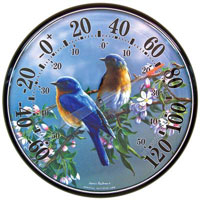Though they may seem like luxury goods, garden thermometers are actually quite useful! Before the rise of weather apps and 24/7 weather channels, all it took for a person to gauge the temperature was a quick look out the window at their garden thermometer. Too low-tech for you? Nowadays, there are even digital outdoor thermometers that can display the forecast, humidity and wind speed. Of course, the accuracy of both low- and high-tech thermometers depends greatly on where you place them.

For the most accurate readings, you’ll need to find the perfect spot in your garden. Here are some big DOs and DON’Ts of thermometer placement that we’ve learned through trial and error.
DO place your thermometer in a shady area. In general, you’ll have better luck in the north side of your home. This is because temperature in the shade tends to be more consistent. In sunny spots, the thermometer will report higher temperatures.
DON’T put it close to objects that may radiate heat, such as asphalt sidewalks or metal siding. These materials absorb the sun’s heat and make their immediate surroundings hotter. Try to find a spot that’s at least 100 or so feet away from pavement.
DO give your thermometer plenty of fresh air. An ideal spot would be in a flat area. At the top of a hill, it’d be too windy, and at the bottom of one, it’d be too sheltered. If your thermometer sits in stagnant air, it won’t give an accurate reading.
DON’T keep the thermometer too close to your house. The National Weather Service advises that thermometers can be too easily affected by the internal temperatures of nearby buildings if they’re kept too close. Therefore, a good rule of thumb is to multiply the height of your house by four, then use the resulting distance to find a place for your thermometer. (For example, if your house is 15 feet tall, place your thermometer 60 feet away from it.)



